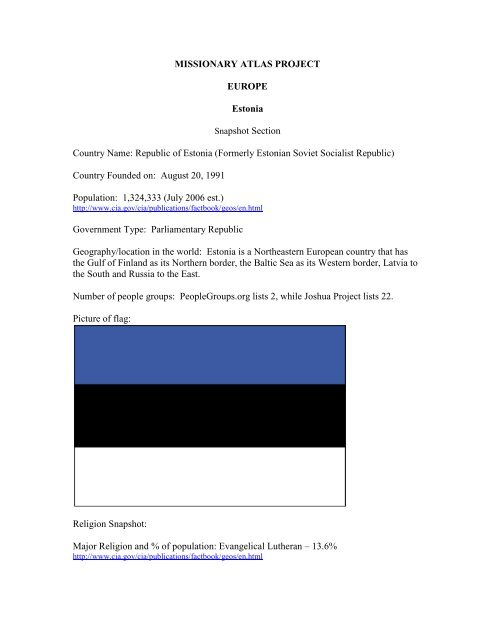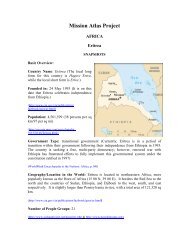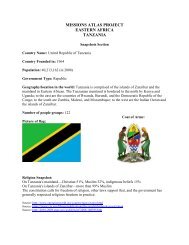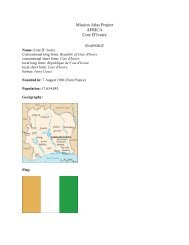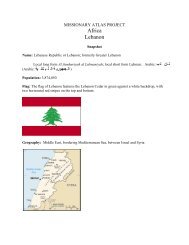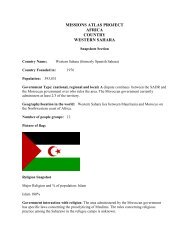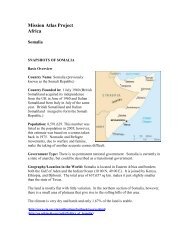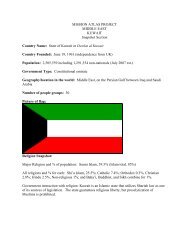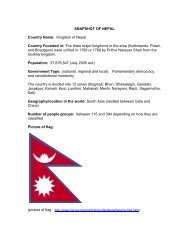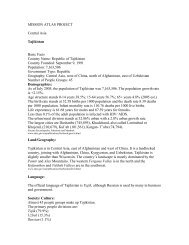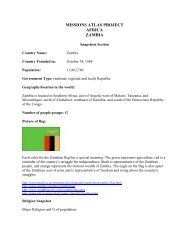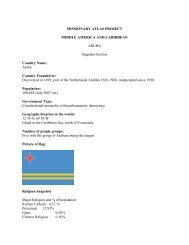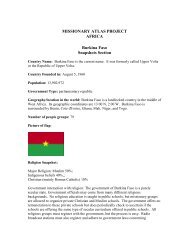Estonia Profile.pdf - WorldMap
Estonia Profile.pdf - WorldMap
Estonia Profile.pdf - WorldMap
Create successful ePaper yourself
Turn your PDF publications into a flip-book with our unique Google optimized e-Paper software.
MISSIONARY ATLAS PROJECTEUROPE<strong>Estonia</strong>Snapshot SectionCountry Name: Republic of <strong>Estonia</strong> (Formerly <strong>Estonia</strong>n Soviet Socialist Republic)Country Founded on: August 20, 1991Population: 1,324,333 (July 2006 est.)http://www.cia.gov/cia/publications/factbook/geos/en.htmlGovernment Type: Parliamentary RepublicGeography/location in the world: <strong>Estonia</strong> is a Northeastern European country that hasthe Gulf of Finland as its Northern border, the Baltic Sea as its Western border, Latvia tothe South and Russia to the East.Number of people groups: PeopleGroups.org lists 2, while Joshua Project lists 22.Picture of flag:Religion Snapshot:Major Religion and % of population: Evangelical Lutheran – 13.6%http://www.cia.gov/cia/publications/factbook/geos/en.html
All religions and % for each:Orthodox – 12.8%Other Christian (including Methodist, Seventh-Day Adventist, Roman Catholic,Pentecostal) – 1.4%Unaffiliated – 34.1%Other and Unspecified – 32%None – 6.1%There are also traces of Buddhists, Muslims, Jewish, and Neopagans (worship Taara, alocal ancient deity).Government interaction with religion: The Constitution of the Republic of <strong>Estonia</strong> states,“'Everyone has freedom of conscience, belief and thought. Belonging to a church orfaith-based organization is voluntary. There is no state church. All are free toengage in acts of worship, in public or in private, as long as this does not impairpublic order, health or morals.”http://www.estonica.org/eng/prindi.html?menyy_id=101&kateg=41&alam=56
The population of <strong>Estonia</strong> is 1,324,333.Major Cities include:Tallinn (Capital) (pop. 401,694 in 2005)Tartu (pop. 100,872 in 2005)Narva (pop. 69,410 in 2005)Kohtla-Järve (pop .44,679 in 2005)Pärnu (pop. 43,528 in 2005)Viljandi (pop. 20,283 in 2005)Country <strong>Profile</strong>Basic FactsDemographics0-14 years: 15.2% (male 103,367/female 97,587)15-64 years: 67.6% (male 427,043/female 468,671)65 years and over: 17.2% (male 75,347/female 152,318) (2006 est.)The median age is 39.3 yearsmale: 35.8 yearsfemale: 42.6 years (2006 est.)The population growth rate is -0.64% with 10.04 births per 1,000 people. The netmigration rate is -3.2% per 1,000 people.Life Expectancy is 72.04 years.male: 66.58 yearsfemale: 77.83 years (2006 est.)Around 7,800 people live with AIDS that reflects to 1.1% of the population living withAIDS. This is the highest prevalence rate in Europe right behind the Ukraine.http://www.cia.gov/cia/publications/factbook/geos/en.htmlhttp://en.wikipedia.org/wiki/<strong>Estonia</strong>#Religionhttp://www.parnu.ee/fileadmin/user_upload/<strong>pdf</strong>/linn_arvudes_eng_2004.<strong>pdf</strong>http://en.wikipedia.org/wiki/List_of_towns_in_<strong>Estonia</strong>LanguageThe official language is <strong>Estonia</strong>n which is closely related to Finnish. Russian is also asignificant language in <strong>Estonia</strong> due to its proximity to Russia and the requirement duringthe Soviet Era in <strong>Estonia</strong>’s history that required that Russian be the official secondlanguage in the classroom.
Other languages spoken in <strong>Estonia</strong> are Ukrainian, Belarussian, Finnish, Latvian andLithuanian.“Sõida tasa üle silla” – “Cross the bridge quietly” is a phrase that characterizes the<strong>Estonia</strong>n language with its quiet, almost melodic sound. Legend says this sentence won<strong>Estonia</strong>n the silver medal in the competition for the world’s most beautiful language.http://en.wikipedia.org/wiki/<strong>Estonia</strong>#Religionhttp://www.estonica.org/eng/prindi.html?menyy_id=1090&kateg=38&alam=101http://www.vm.ee/estonia/kat_173/pea_173/413.htmlSociety/Culture<strong>Estonia</strong> is a very urbanized country with nearly one-third of its population living in thecapital city of Tallinn. The northern portion of the country is much more populated thanthe south, with the only highly populated areas in the south being Tartu, the cultural andprobably educational center of the country, and Pärnu, a seaside resort city. The urbanpeoples of <strong>Estonia</strong> mostly consist of Russians while <strong>Estonia</strong>ns hold closer ties to rurallife. This tie to rural even extends into the everyday life of an urban native <strong>Estonia</strong>n.Outdoor sports also play an important role in the society of <strong>Estonia</strong>. Sports such asbasketball, soccer, and ice hockey are very popular as are leisure activities includinghorseback riding, bird-watching, cross-country skiing, and boating.<strong>Estonia</strong>n society and culture has been influenced by many neighboring countriesthroughout its history. Denmark and Sweden played a significant role by building thecapital city of Tallinn and founding the University of Tartu in 1632, four years before thebeginning of Harvard in the United States. Despite the closeness of Russia, of all itsbordering countries, Russia has had the least influence over the centuries minus a few ofthe “Russifications” ordered by the authorities during the Soviet Era.In the 16 th and 17 th centuries, as in many countries, <strong>Estonia</strong> experienced a conflictbetween Catholicism and Protestantism. Protestantism won out in the end and led to agreat cultural interest in the written word, something not greatly emphasized by theCatholic Church during that time. As a result, writers became not only authors in the eyesof those around them but also spiritual leaders.During the Soviet Era, <strong>Estonia</strong>n culture was squelched. As a result, when independencewas finally achieved in 1991, the cultural centers exploded and grew very rapidly as<strong>Estonia</strong>ns sought to once again define their culture and claim it as their own. Music,theater, and dance once again became very important.During the Soviet Era, many of their folk and national songs were banned. However,beginning with the push for independence that culminated in 1991, song festivals wereheld in which the previously banned songs were once again sung in public. Even todaynational song festivals are held in Tallinn and Tartu. <strong>Estonia</strong>ns have one of the largestcollections of folk songs in the world, numbering 133,000 written down.
<strong>Estonia</strong> has a national opera, ballet and drama theater, all located in the capital city ofTallinn. <strong>Estonia</strong>ns are striving to hold to their own culture in a world that seems to begrowing smaller and smaller each day.http://encarta.msn.com/encyclopedia_761563693_2/<strong>Estonia</strong>.htmlhttp://www.estemb.org/lang_4/rub_62/rub2_840/rubviide_204Government<strong>Estonia</strong>n has been a parliamentary republic since their independence from the USSR in1991. The President is elected by Parliament, the Riigikogu, for a five-year term and isthe Supreme Commander of the National Defence of <strong>Estonia</strong>. The Prime Minister, whoacts as more the head of the government than the President, is nominated by the Presidentand approved by Parliament. President Arnold Ruutel is currently in office along withPrime Minister Andrus Ansip, but elections will be held during the fall of 2006.Parliament, the Riigikogu, is made up of 101 seats and members are elected by popularvote for a four-year term. These elections are held during the spring with the nextRiigikogu election occurring in March of 2007.<strong>Estonia</strong> also has a National Court of judges where the chairman of the National Court isappointed by Parliament and holds the office for the extent of his life. The Republic of<strong>Estonia</strong> existed from 1918 until Soviet occupation in 1940. When independence wasdeclared in 1991, this country was once again formed and they quickly drew up a newconstitution, approved in 1992. This constitution established the Republic of <strong>Estonia</strong> as aparliamentary democracy and gave the right to vote to all citizens over the age of 18.The Riigikogu holds a large portion of the power in <strong>Estonia</strong> as indicated above. Therequirements to vote for members of the Riigikogu stand at being 18 and a citizen of thecountry. However, to be a member of the Riigikogu, one must be 21, be able to speak<strong>Estonia</strong>n fluently, and be a citizen. Those running for the Riigikogu find themselves in avery different situation than Americans might expect them to be. As politicians theysurprisingly disconnected from the people. A Riigikogu member is elected based on thenumber of votes he/she receives, the number of votes their party receives and how highup on the list they are within their party. It is possible for a member to be elected withvery few personal votes based on the fact that they were high on the list of their party andtheir party received a high number of votes. Each party must receive a minimum of 5% ofthe country’s vote to be considered for a place in the Riigikogu.There are women present in the Riigikogu, although in 2001 only 18 of 101 memberswere women.In 2003, there were 11 parties represented in the Parliamentary election, with somereceiving as little as 990 votes out of about 501,000. The following is a list of theseparties with a short description:Centre Party of <strong>Estonia</strong> (Eesti Keskerakond)
This party is left of center, social liberal party and was founded in October 1991, thusbeing one of the oldest parties in <strong>Estonia</strong>Union for the Republic - Res Publica (Ühendus Vabariigi Eest - Res Publica)This conservative political party was formed in December of 2001. This party currentlyholds the largest number of seats in the Riigikogu with 28 in number.<strong>Estonia</strong>n Reform Party (Eesti Reformierakond)This party is a free market liberal party that was founded in 1991. The current PrimeMinister Andrus Ansip is the leader for this party.People's Union of <strong>Estonia</strong> (Eestimaa Rahvaliit)The original name for this party was <strong>Estonia</strong>n Country People’s Party with its inceptionin September of 1994. However, the name was changed in 1999. The party is an agrarianparty with populist tendencies, even though they claim nationalism as their officialstance.Pro Patria Union (Isamaaliit)The literal meaning of this party’s name is the Fatherland Union. They mix what theyterm Christian democracy with nationalism and were formed in 1995.Social Democratic Party (Sotsiaaldemokraatlik Erakond or SDE)Formerly known as the Moderate People’s Party, this party was actually formed in 1990and focus on social democracy.Constitution Party (Konstitutsioonierakond)<strong>Estonia</strong>n United People's Party is the original name for this party founded in 2005. Thisparty is a minority party that central-left in its ideology and is mainly supported by theRussian minority.<strong>Estonia</strong>n Christian People's Union (Eesti Kristlik Rahvapartei)This party is a Christian-conservative party that is opposed to the European Constitution.<strong>Estonia</strong>n Independence Party (Eesti Iseseisvuspartei)This party opposes <strong>Estonia</strong> being a part of the European Union and has held noparliamentary seats.<strong>Estonia</strong>n Left Party (Eesti Vasakpartei - EVP)Formerly known as the <strong>Estonia</strong>n Social Democratic Labour Party, this party currentlyholds no parliamentary seats and a left socialist political party founded in 1990.Russian Party in <strong>Estonia</strong> (Vene Eesti Erakond)
IndependentsThe government is essentially the arm of the Riigikogu in <strong>Estonia</strong>. They carry out thedomestic and foreign policy set by the Riigikogu. This branch is headed by the PrimeMinister and the members of the government are called ministers as well. Theseministers represent the interests of their ministry to the government and then they alsotend to head up that ministry. The government in 1999 put into place two additionalministers to the 12 already in place who have no ministry they are heading up. Their jobs,respectively, are to head up population issues and regional issues.http://www.cia.gov/cia/publications/factbook/geos/en.htmlhttp://encarta.msn.com/encyclopedia_761563693_4/<strong>Estonia</strong>.htmlhttp://www.estonica.org/eng/prindi.html?menyy_id=711&kateg=39&alam=48http://en.wikipedia.org/wiki/Politics_of_<strong>Estonia</strong>Economy<strong>Estonia</strong> is a member of the World Trade Organization as well as the European Union.They have connected their currency, the <strong>Estonia</strong>n Kroon, to the Euro as most otherEuropean Union countries have done. They will make a complete transfer to the Eurosometime in 2007. The two strongest areas of their economy, telecommunications andelectronics, are influenced by their three top trading countries, Finland, Sweden andGermany. Public debt is low generally and the state budget is, for the most part, inbalance.The GDP per capita for the year 2005 was $16,700. 66.8% of the GDP came fromservices, 29.1% from industry and 4.1% from agriculture. These numbers are mostlyreflective of the labor force as well (69% in services, 20% in industry and 11% inagriculture) while the unemployment rate stands at 9.2%.The main agricultural products in <strong>Estonia</strong> are potatoes, vegetables, livestock and dairyproducts and fish. The industries include engineering, electronics, wood and woodproducts, textile, information technology and telecommunications.When <strong>Estonia</strong> declared its independence in 1991, they quickly changed from theeconomic set-up of a Soviet state to a free-market economy. This was the fourtheconomic transformation the country had undergone in the 20 th century. At the beginningof the 1900’s, <strong>Estonia</strong> was an agrarian country with peasantry farming large estatesowned by foreigners. In 1918, <strong>Estonia</strong> declared themselves free from Russia and split thelarge farms into small farms and distributed them among the people.After World War II, Soviet Russia once again took <strong>Estonia</strong> under its control, put all of thesmaller farms back into large conglomerations, and began pushing the industrial side ofthe economy. <strong>Estonia</strong> was the USSR’s gate to the Western world and as a result receivedmuch more exposure to western ideas. When they declared independence in 1991,<strong>Estonia</strong> made use of these ideas and connections to develop their free-market economy.
Exports make up a large portion of <strong>Estonia</strong>’s economy today. Due to this fact, <strong>Estonia</strong>nsare very open to foreigners entering their country.If you want more detailed info about <strong>Estonia</strong>’s economy, the following is a very good,detailed resource:http://www.estonica.org/eng/prindi.html?menyy_id=1117&kateg=40&alam=81http://www.cia.gov/cia/publications/factbook/geos/en.htmlhttp://encarta.msn.com/encyclopedia_761563693_3/<strong>Estonia</strong>.htmlIn 2003, the posted literacy rate was 100%.http://www.infoplease.com/ipa/A0107501.htmlLiteracyLand/Geography<strong>Estonia</strong> is a Northeastern European country that has the Gulf of Finland as its Northernborder, the Baltic Sea as its Western border, Latvia to the South, and Russia to the East. Itcovers a total of 45,226 sq. km. and includes 1,520 islands in the Baltic Sea. This wouldbe slightly smaller than New Hampshire and Vermont combined.The west coast is covered in beaches with access to the many islands off the coast in theBaltic Sea. Pärnu is the main city on the western coast of <strong>Estonia</strong> and is known for itsbeautiful resorts, well-manicured parks, and quaint architecture. There are also castlesand other resorts some that were frequented by the Russian royalty, located in thesurrounding cities. Haapsalu is known for the town’s 19 th century feel and 13 th centurycastle located at the heart of the town. The countryside is scattered with windmills,fishing villages and thatched cottages.Southern <strong>Estonia</strong> is made up of forest-covered hills. Tartu, the home of one of <strong>Estonia</strong>nsgreatest Universities, makes up a portion of Southern <strong>Estonia</strong>. The pace in this portion of<strong>Estonia</strong> is very laid back and quiet. One of the unique parts of Southern <strong>Estonia</strong> is thesettlement of Setus, an ancient <strong>Estonia</strong>n people. These people still speak their ownlanguage, have a very distinctive dress, and live in wooden huts.In Northern <strong>Estonia</strong>, one can stand at the top of jagged cliffs that plummet into the depthsof the Baltic Sea and Gulf of Finland. The Gulf provides equal access to both Helsinkiand St. Petersburg.Lahemaa National Park is located on this northern coast and includes forest, wetlands,and hiking trails through the jagged cliffs making up the coastline. Castles, restoredmanor estates, and waterfalls are found throughout the countryside between Tallinn, thecapital, and Narva, <strong>Estonia</strong>’s easterly city. Narva is located on the river border betweenRussia and <strong>Estonia</strong> and has a unique culture as a result of these two cultures meeting.
<strong>Estonia</strong> has beautiful cities and beautiful countryside. With a majority of the peopleliving in the cities, much of the countryside has been left untouched for years allowing itto grow to its natural state.<strong>Estonia</strong> is separated into what they refer to as Higher and Lower <strong>Estonia</strong>. Many of the<strong>Estonia</strong>ns have chosen to settle in the west and the north with things being centered onindustry and service. However, in lower <strong>Estonia</strong> (the east and the south) the economy iscentered on agriculture that has yet to be as profitable as it once was. Those people on thecoast are developing the fishing and tourist trades that have helped their situations in life.Many of the people who live in the lower inlands have begun a migration to the cities.www.visitestonia.comhttp://www.estonica.org/eng/prindi.html?menyy_id=497&kateg=38&alam=45http://www.infoplease.com/ipa/A0107501.htmlHistoryThe history of <strong>Estonia</strong> can be traced back to 2500 B.C., which makes this country thelongest settled European people in Europe. The <strong>Estonia</strong>n language emerged as its ownlanguage around 500AD.13 th – 14 th CenturiesTeutonic Knights came to <strong>Estonia</strong> building castles, imposing Christianity, and bringingtheir fellow Germans with them. The Teutonic Knights were a German Roman Catholicorder founded in the 12 th century in Jerusalem. The Baltic trade routes, along with thespread of Christianity, were the reasons for taking control. At the same time, in 1219 theKing of Denmark, Waldemar II, built a fortress in the place that would later become thecity of Tallinn. However, in 1345 Denmark sold their territories to the Livoninan Order, apart of the Teutonic Knights after some two years of uprisings.16 th – 17 th CenturiesDuring the 16 th century, Russia, Poland, and Sweden began taking an interest in <strong>Estonia</strong>.In 1561, the nobility of northern <strong>Estonia</strong> received the protection of Sweden while theKnights continued to be expelled from <strong>Estonia</strong>. By 1591, the Teutonic Knights had beencompletely run out of <strong>Estonia</strong>. Until 1645, Poland had possession of the southern portionof <strong>Estonia</strong>, including Tartu. However by 1645, Sweden had taken control of the entireregion. The 1670’s and 1680’s led to many developments by the Swedes that benefitedthe people, one of which was the formation of the University of Tartu in 1632. Thisbenefited the people, but the nobility became resentful of the Swedes success.18 th – 19 th CenturiesIn 1721, <strong>Estonia</strong> was granted to Russia as spoils of war from the Great Northern Warbetween Sweden and Russia. Peter the Great returned the power of the <strong>Estonia</strong>n nobility
and by 1819 Alexander I abolished serfdom that had been in place since the Germaninvasion of the 13 th century. Peasants were allowed to purchase land and as a result,<strong>Estonia</strong>ns began developing a great sense of national being.20 th CenturyThe country we now know as <strong>Estonia</strong> was developed through the country’s trials duringthe 20 th century. On February 24, 1918, <strong>Estonia</strong> declared itself the Republic of <strong>Estonia</strong>,independent from Russian rule. This was possible due to the fall of the monarchy inRussia in the Russian Revolution in 1917. Two years of fighting with the Bolsheviks,who now had control of Russia, finally resulted in Russia recognizing <strong>Estonia</strong>’sindependence. Two years later the USSR was formed minus the country of <strong>Estonia</strong>.In 1921, <strong>Estonia</strong> joined the League of Nations and signed a mutual defense pact withLatvia and Lithuania in 1934. From its initial declaration of independence, <strong>Estonia</strong> was ademocracy focusing itself around its parliament. However, in 1934 the then PrimeMinister Konstantin Päts led a coup and established authoritarian rule by dissolvingparliament. Four years later <strong>Estonia</strong> drew up a new constitution that set-up a presidentialgovernment with a bicameral legislature where Päts was elected president.In June 1940, Soviet troops occupied <strong>Estonia</strong> and in the next election, only Sovietapproved candidates were allowed to participate. By August 6, 1940, <strong>Estonia</strong> was officialincorporated into the USSR as the <strong>Estonia</strong>n Soviet Socialist Republic. As part of WorldWar II, Germany attacked the USSR and occupied <strong>Estonia</strong> in July of 1941. Estimates say90,000 <strong>Estonia</strong>ns died during World War II, 60,000 of those being a direct result ofSoviet occupation rather than the short time Nazi Germany held control. Three yearslater the Nazi’s retreated out of <strong>Estonia</strong> and 60,000 <strong>Estonia</strong>ns fled to Sweden andGermany as a result of the returned rule of the Soviet party. <strong>Estonia</strong> lost a total of onequarter of its population either to death, deportation, or flight. By early 1945, there wereno more that 800,000 people left in <strong>Estonia</strong>, 97-98% of those being ethnically <strong>Estonia</strong>n.During the reign of the Soviets, <strong>Estonia</strong>n language and culture suffered greatly. Thelanguage was suppressed in the schools and in general society. The Communist Party wasthe only legal political party and those who opposed them or were even suspected ofopposition were sent to the Gulags, soviet concentration camps many of which were inSiberia.During this time, the population of <strong>Estonia</strong>ns in <strong>Estonia</strong> decreased due to the Gulags,immigration to other countries when possible, or even death. Scores of Russians migratedin to work in the new factories that were built in northern <strong>Estonia</strong>.In January of 1987, the Soviet leader Mikhail Gorbachev announced his belief that theSoviet regime needed to be “democratized.” This was the beginning of the end of Sovietrule in <strong>Estonia</strong>. In 1987 <strong>Estonia</strong>ns came together to protest a plan to expand phosphoritemining that would damage the local ecosystem. When the protests worked and theplanned expansion was halted, the <strong>Estonia</strong>n people realized they could make a difference.
ReligionNon-ChristianBuddhistsTraces are found with two congregations known. The number of adherents is not known.MuslimsIn 2003 there were approximately 20,000 known Muslims. A majority of these Muslimsare of the Tatar and Azer ethnic origins. They follow the Shi’a school of thought withinthe Muslim belief system.JewishIn 2003 there were approximately 3,000 followers of Judaism in <strong>Estonia</strong>.NeopagansFollowers believe in a local ancient deity named Taara. The belief system has its roots inFinnish folk religion. In a poll taken of 1000 <strong>Estonia</strong>ns, 6% said they held to a belief inTaara, however it is not know officially how many adherents there are to this particularreligion or if this percentage is a true representation of the population as a whole.Catholics/Orthodox Churches<strong>Estonia</strong>n Apostolic-Orthodox ChurchThis is the second largest church with 58 congregations and approximately 18,000members registered with the Ministry of Internal Affairs.Russian Orthodox ChurchThere is a somewhat significant number of Russian Orthodox Churches in <strong>Estonia</strong>, but asthey have yet to register with the government, they are not sure of the total number ofcongregations.Old BelieversThere are approximately 15,000 followers and 11 congregations across <strong>Estonia</strong>. The OldBelievers practice what they would call the pure form of Russian Orthodoxy. They aredescendents of Russians who fled religious persecution by Patriarch Nikon in the 1650’s.Patriarch Nikon reformed the Russian Orthodox Church to be more in line with the Greek
Orthodox Church. The Old Believers rejected his reforms and thus brought themselvesunder persecution.Church of Jesus Christ of Latter-day Saints (Mormon)In 1997 there were approximately 300 adherents and 3 congregations across the nation.Jehovah’s WitnessesIn 1998 there were approximately 3,846 and 43 congregations across the nation.Non-ReligiousThe non-religious made up of atheists, communists, and other non-believers make uparound 60% of the people in <strong>Estonia</strong> or 843,000 persons. This group outnumbers allgroups (including Catholic, Orthodox, and Protestant) by over 200,000Protestant/Evangelicals/Pentecostals<strong>Estonia</strong>n Evangelical Lutheran ChurchThis is the largest church in <strong>Estonia</strong>. They have approximately 170 congregations andapproximately 175,000 members. <strong>Estonia</strong> has never had an official state church, but dueto the long history of Lutheranism in <strong>Estonia</strong>, it has become the most prominent religionin <strong>Estonia</strong>.http://www.eelk.ee/english.phpAlliance of <strong>Estonia</strong>n Evangelical Baptist CongregationsThe third largest church in <strong>Estonia</strong> is the Baptist Church. They consist of 89congregations and approximately 6100 members.Christian PentecostalThe groups reports over 45 congregations with more than 3250 membersNew Apostolic ChurchThis independent group has 14 congregations with more than 3000 total membersMethodistThe Methodists have some 19 congregations with around 1900 membersUnion of church Free Congregations
The group claims 6 congregations and 1200 membersAll other denominations together report 126 congregations and 13000 members.000000Armenian (pop. 1,707)People GroupsArmenians, by culture and history, are Christian. The Apostolic Catholic Church is a keypart of their Armenian identity. They do not see being a Christian as entailing a personalrelationship with Christ, is merely a part of who they are nationally. They considerthemselves born Christians. Traditionally they occupy the region around Mount Ararat inTurkey, although they are found around the world. The Armenian Republic dates back to1920 officially and at one time were under Soviet Russian rule.There are 1,707 Armenians found in <strong>Estonia</strong>. Their traditional language is Armenian.50% of the Armenians in <strong>Estonia</strong> are considered Christian, but it is unknown whatnumbers of those are evangelical.http://www.joshuaproject.net/peopctry.php?rop3=100516&rog3=EN000000Azerbaijani, North (pop. 1,311)The Azerbaijani, like the <strong>Estonia</strong>ns, are a people who have been subject many invasionsthroughout their history. Due to the tribal nature, and these invasions, the Azerbijanihave spread themselves through Central Asia and even to other parts of the world. Thepopulation of Azerbijani in <strong>Estonia</strong> numbers 1311. Their native language is that of theNorthern Azerbijani and the number of Christians within their population is unknown.Their primary religion is Islam.http://www.joshuaproject.net/peopctry.php?rop3=100675&rog3=EN000000Byelorussian (pop. 8,841)The Byelorussians are of Eastern Slavic decent and are considered a Eurasian peoplegroup. Their native language is Belarussan and come from Belarus. Traditionally theyare of the Eastern Orthodox faith, but it is unknown how many are Christian.http://www.joshuaproject.net/peopctry.php?rop3=101833&rog3=EN000000Chuvash (pop. 1,209)
The Chuvash people are of Turkic decent, the largest populations of which are found inChuvashia. Chuvashia is located in the western portion of Russia. Those located in<strong>Estonia</strong> speak Chuvash and are considered 35% Christian. As far as is known, onlyportions of the Bible have been translated into Chuvash. They have yet to have an entireBible in their native language.http://www.joshuaproject.net/peopctry.php?rop3=102226&rog3=EN000000Deaf (pop. Unknown)The deaf in <strong>Estonia</strong> use an <strong>Estonia</strong>n Sign Language. They are Christian, but thepercentages of Christians and evangelicals are unknown.http://www.joshuaproject.net/peopctry.php?rop3=114916&rog3=EN102954<strong>Estonia</strong>n, Estlased (pop. 853,303)The <strong>Estonia</strong>ns are native to the area and speak <strong>Estonia</strong>n. They are considered to begenerally Christian, Lutheran although they are not very evangelical. 80% of all<strong>Estonia</strong>ns live in <strong>Estonia</strong>, the other 20% are spread throughout the world, with the highestconcentrations being in Germany, Russia, Sweden, and the United States.http://www.joshuaproject.net/peopctry.php?rop3=102954&rog3=EN000000Finnish (pop. 16,086)The Finnish people are one of the larger minorities in <strong>Estonia</strong>, probably due to theirnative country’s close proximity. The Finnish people speak Finnish and are traditionallyChristian. Of those found in <strong>Estonia</strong>, 87% claim Christianity. They are consideredevangelical to a certain degree.http://www.joshuaproject.net/peopctry.php?rop3=103021&rog3=EN000000Georgian (pop. 600)The Georgians are of Eurasian decent and actually trace their heritage back to Japheth,son of Noah. They speak Georgian and are considered 30% Catholic , with Christianitybeing their primary religion. Less than 5% are evangelical and they have a full Bibletranslation in their own language.http://www.joshuaproject.net/peopctry.php?rop3=103298&rog3=EN000000
German (pop. 3719)The native language for Germans is German. They are of Eurasian decent. Of thepopulation in <strong>Estonia</strong>, 78% are Christian and greater than 10% of those are evangelical.http://www.joshuaproject.net/peopctry.php?rop3=103305&rog3=EN000000Ingrian (pop. 803)This people group, also known as the Ingrian Finns, are from Ingria, a small country thatwas once a part of Finland and is now part of Russia, in the St. Petersburg region.Ingrians speak Finnish or Russian, depending on where they now reside. During WorldWar II, the many of the Ingrians were dispersed, killed, or displaced to Siberia, CentralAsia and various other regions. Very few Ingrians were left in their native land. At theend of World War II, many Ingrians settled in <strong>Estonia</strong>. Not much is left of their originalculture, but many stick to their Finnish roots religiously and hold to the Lutheran church.There are no Bibles in the Ingrian language, but this does not seem to be a deterrent asvery few Ingrians speak a national language of their own.http://www.joshuaproject.net/peopctry.php?rop3=104135&rog3=ENhttp://en.wikipedia.org/wiki/Ingrian_Finns000000Jew, Eastern Yiddish-Speaking (pop. 4,827)The Jews in <strong>Estonia</strong> speak Eastern Yiddish, a combination of Hebrew, German andvarious other local bits of language. Their religion is Judaism, but less than 5% adhere tothis religion. So far there is no missionary work targeting this people group in <strong>Estonia</strong>.http://www.joshuaproject.net/peopctry.php?rop3=104247&rog3=EN000000Karelian (pop. 904)The Karelian are descendants of the Finno-Ugric peoples. They speak Karelian and ofthe population in <strong>Estonia</strong>, 67% are Christian. Less than 5% are evangelical, but the rate ofnew fellowships is accelerating. For more info on the native Karelian people:http://en.wikipedia.org/wiki/Karelianhttp://www.joshuaproject.net/peopctry.php?rop3=104657&rog3=EN000000Latvian (pop. 2,012)
The Latvian people in <strong>Estonia</strong> speak Latvian and are 90% Christian. One congregationper 100,000 individuals is evangelical in nature. Most are Lutheran, but there are somewho hold to the Russian Orthodox or Roman Catholic faith.http://www.joshuaproject.net/peopctry.php?rop3=105674&rog3=EN000000Lithuanian (pop. 2,012)The Lithuanians have many similarities to the Latvians. They are both Baltic peoples.However, the Lithuanians tend more toward the Roman Catholic tradition. Of thoseliving in <strong>Estonia</strong>, 85% are Roman Catholic. Their native tongue is Lithuanian.http://www.joshuaproject.net/peopctry.php?rop3=105803&rog3=EN000000Moldavian (pop. 1,311)The Moldavian peoples originally come from what is now known as Romania.Moldavia, their native country, has not officially existed for over 100 years. There is aRepublic of Moldova, a former part of the USSR. Ethincally, the Moldavians are stillconsidered a people group and their native tongue is Moldovan, but it is essentially thesame as Romanian. Of the Moldavians who live in <strong>Estonia</strong>, 82% are Christian.http://www.joshuaproject.net/peopctry.php?rop3=106730&rog3=ENhttp://en.wikipedia.org/wiki/Moldavianhttp://en.wikipedia.org/wiki/Republic_of_Moldova000000Mordvinian (pop. 1,006)The Mordvins are native to the republic of Mordovia, part of the Russian Federation.The <strong>Estonia</strong>n Mordvinian’s native language is Erzya. Of those living in <strong>Estonia</strong>, theprimary religion is Christianity. 65% of the Mordvins consider themselves Christian.http://www.joshuaproject.net/peopctry.php?rop3=106791&rog3=ENhttp://en.wikipedia.org/wiki/Mordvinian000000Polish (pop. 2,510)The Polish people are of Slavic decent and their native language is Polish. Of those livingin <strong>Estonia</strong>, the primary religion is Christianity. However, it is not know how manyactually consider themselves Christian. There are currently mission agencies targetingthis people group.http://www.joshuaproject.net/peopctry.php?rop3=108096&rog3=EN
108452Russian (pop. 398,005)The largest minority in <strong>Estonia</strong> is the Russian minority. These people speak Russian andmany of them speak only Russian. Russian Orthodox is the main religion among thesepeople although only 31.3% of those living in <strong>Estonia</strong> actually claim any form ofChristianity as their religion.http://www.joshuaproject.net/peopctry.php?rop3=108452&rog3=EN000000Swedish (pop. 30)Of Scandinavian decent, the Swedes of <strong>Estonia</strong> make up the smallest minority in thecountry, which is surprising considering the part Sweden has played in the history of<strong>Estonia</strong>. Their native language is Swedish and while Christianity is their primary religion,it is unknown how many Swedes in <strong>Estonia</strong> claim Christianity personally.http://www.joshuaproject.net/peopctry.php?rop3=109650&rog3=EN000000Tatar (pop. 3,516)The Tatar are of Turkic decent and are spread throughout nearly every former republic ofthe USSR. There are over 7 million Tatars in the world. Tatar is their native language andIslam is their primary religion. Most of the Tatars in <strong>Estonia</strong> are Sunni Islam. Less than2% of the <strong>Estonia</strong>n Tatars consider themselves part of any Christian religion.http://www.joshuaproject.net/peopctry.php?rop3=109874&rog3=EN000000Ukrainian (pop. 24,226)Ukrainians make up the third largest population in <strong>Estonia</strong>. The Ukrainian culture has tiesboth to the Polish and Cossack traditions. Their native language is Ukrainian and theirprimary religion is Christianity. Of those living in <strong>Estonia</strong>, 69% consider themselvesChristian.http://www.joshuaproject.net/peopctry.php?rop3=110376&rog3=EN000000Uzbek, Southern (pop. 600)The Uzbeks are of Turkic decent. There are two Uzbek people groups, the northern andthe southern. The northern are found primarily in Uzbekistan, but the southern are foundprimarily in Afghanistan. Of the 2.5 million Southern Uzbeks in the world, only 15,000
live in Uzbekistan with over 2.4 million of them living in Afghanistan. Their nativelanguage is Uzbek, Southern and their primary religion is Sunni Islam.http://www.joshuaproject.net/peopctry.php?rop3=110472&rog3=ENMissiological Implications1. Evangelical Christians and Churches must be most concerned about the largenumbers of non-religious persons in <strong>Estonia</strong>. These persons should be the primarytarget group for evangelistic efforts. New churches should be planted precisely toattempt to reach this group.2. Evangelical Christians and Churches should also target the 398,000 Russians in<strong>Estonia</strong>. Many of these persons will be counted in the non-religious group butmany also are simply unchurched. Definite plans for evangelizing the nonreligiousin <strong>Estonia</strong> is a much needed ministry.3. Evangelical Christians and churches should seek means to evangelize the Jewishpeoples in <strong>Estonia</strong>. Only 5 % of these actually participate in the Jewish religion.Christians should seek ways to start churches that target this group.4. Evangelical Christians and churches should seek to associate with the Lutheranchurches in <strong>Estonia</strong> and find ways to cooperate with them in their ministries.5. Evangelical Christians and churches should seek means to reach the youth of<strong>Estonia</strong>. These young people of <strong>Estonia</strong> are like many in other countries, as theybelieve religion is for the elderly and that they will find God when they reach theage that they need him. Only 15% of the young claim to follow any type ofChristian/Protestant faith. The young people of this country need Christ.6. Evangelical Christians and churches should seek to aid the churches in <strong>Estonia</strong> inleadership training. Some schools are attempting to train both pastors and layleaders but are not able to meet the need for trained leadership.7. Evangelical Christians and churches should seek to help the people in <strong>Estonia</strong> tocombat the less desirable effects of capitalism. While the introduction ofcapitalism has brought a measure of wealth and luxury to the country, theseadvances have been accompanied by a moral lapse. Evangelicals need to share thebiblical teachings of productivity without the problems of moral decay.Linkshttp://www.estonica.org/http://www.culture.ee/http://www.vm.ee/estoniahttp://www.estemb.org/lang_4/rub_62/rub2_856/rubviide_1847#general


